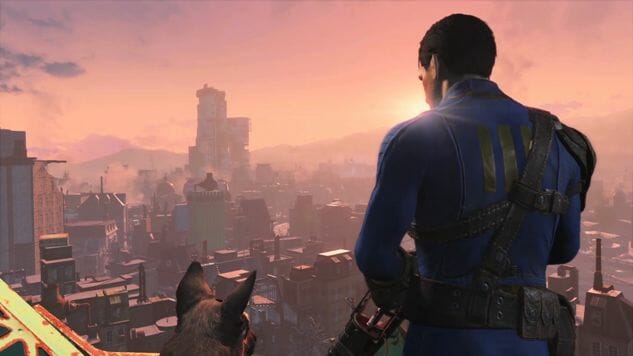Fallout 4: I’m in Love with Massachusetts

Fallout 4 starts with a character saying that war never changes. It’s a bit of a joke, a knowing wink at that hoary cliché, voiced by a character who, if you so choose, disappears early in the game. It’s not war that never changes, Fallout 4 argues, but what comes after.
Entertainment’s been pushing one kind of apocalypse on us so hard, and for so long, that survivors will probably be a little disappointed if the world after the bomb (or virus, or zombie outbreak) isn’t a scorched wasteland full of dilapidated buildings and roving bands of marauders. This idea of a burned Earth didn’t start with Mad Max. It didn’t even start with the Bible and that over-the-top series finale known as the Book of Revelation. Death by fire is a primal theme that goes back to the very foundation of human experience, a fundamental fear that Fallout has always used as a starting point for its apocalyptic vision. It’s as if that nuclear fire burned away the drudgery of our real-world everyday lives and awakened the superhuman survivalist in all of us.
Fallout 4 gives us what we expect. There’s danger in this wasteland, everywhere we turn. Radiation transforms regular animals into horrible monsters. Humans are twisted into feral ghouls, super mutants and, most monstrously of all, amoral murderers who will kill us for no reason. Our vault-dweller is walking, always walking, often while crouched down to sneak up on enemies, until we have discovered enough locations to fast travel. We collect guns, armor, drugs and so much junk that our backs almost break until we begrudgingly drop every microscope, camera and biometric scanner we’ve picked up along the way. Sometimes we’re alone, sometimes we’re with a computer-controlled buddy who cannot be killed, and sometimes we’ll accidentally shoot a friendly face right between the eyes because they kind of snuck up on us, which isn’t smart to do in a place as dangerous as the wasteland, or when we’re holding a controller with a shoulder button as hair-trigger as the Dual Shock’s.
It’s what we expect, but in a new part of the country. These scavengers, blasted trees and crumbling city blocks are in New England, not DC or the West Coast, and if you’re familiar with coastal Massachusetts you might get a thrill simply from seeing places you recognize. If I had to spend the apocalypse somewhere, Boston would be one of my top choices, and I’m glad to see the makers of Fallout 4 agree. As a former local, Fallout 4’s Boston is more satisfying than the one found in The Last of Us, even if it’s based not on the Boston of today but its footprint from the 1950s. Missions take us down the Freedom Trail, inside a ballpark that is Fenway in everything but name, and through some of the most iconic buildings in our country’s history. (I hope I don’t have super mutant flashbacks the next time I visit Faneuil Hall.) You can even venture up the North Shore and check out Revere and Salem, although sadly you can’t get any fried clams at Woodman’s or the Clam Box. Even if this game lacked the memorable characters and stories of previous Fallouts, I would still be in love with its recreation of a city I miss living in. I imagine DC residents past and present felt the same way about Fallout 3.
Fortunately those characters and stories are rich and varied. Our vault-dweller might be a bit of a dud—it’s another fairly anonymous point-of-view character, no matter if you play as a man or a woman, who has a deeply meaningful and personal quest that they’re willing to regularly postpone to help out random people they just met—but there are a few companions who might make the next revision of that list we published last week. Two of the best put a novel Fallout spin on the old Hollywood tropes of the intrepid girl reporter and the hardboiled detective, infusing the backstories of this would-be Lois Lane and Sam Spade with the apocalyptic sci-fi goofiness these games are known for. The newsboy cap and rumpled trench coat might be a bit on the nose, but nobody’s ever accused Fallout of being too subtle.
To wit: the enemy is science. Not the science that destroyed civilization (that was hundreds of years ago, in the game’s timeline) but, essentially, MIT. What was once an esteemed school for nerds and brilliant pranksters is now a shadowy malevolent force that kidnaps unassuming citizens and replaces them with highly life-like synthetic doppelgangers. The Institute, as it’s know, doesn’t rank among the great villains of videogames because it remains in the background for too long. Its army of synths are less imposing than other enemies in the game, and the Institute as a whole is too faceless and invisible for its goals to provoke any kind of dread. This doesn’t make the main quest line a drag, or anything—the game’s major set-pieces are thrilling, and most of them come during your pursuit of the Institute—but you might find the optional side-missions more narratively or intellectually stimulating.
-

-

-

-

-

-

-

-

-

-

-

-

-

-

-

-

-

-

-

-

-

-

-

-

-

-

-

-

-

-

-

-

-

-

-

-

-

-

-

-









































